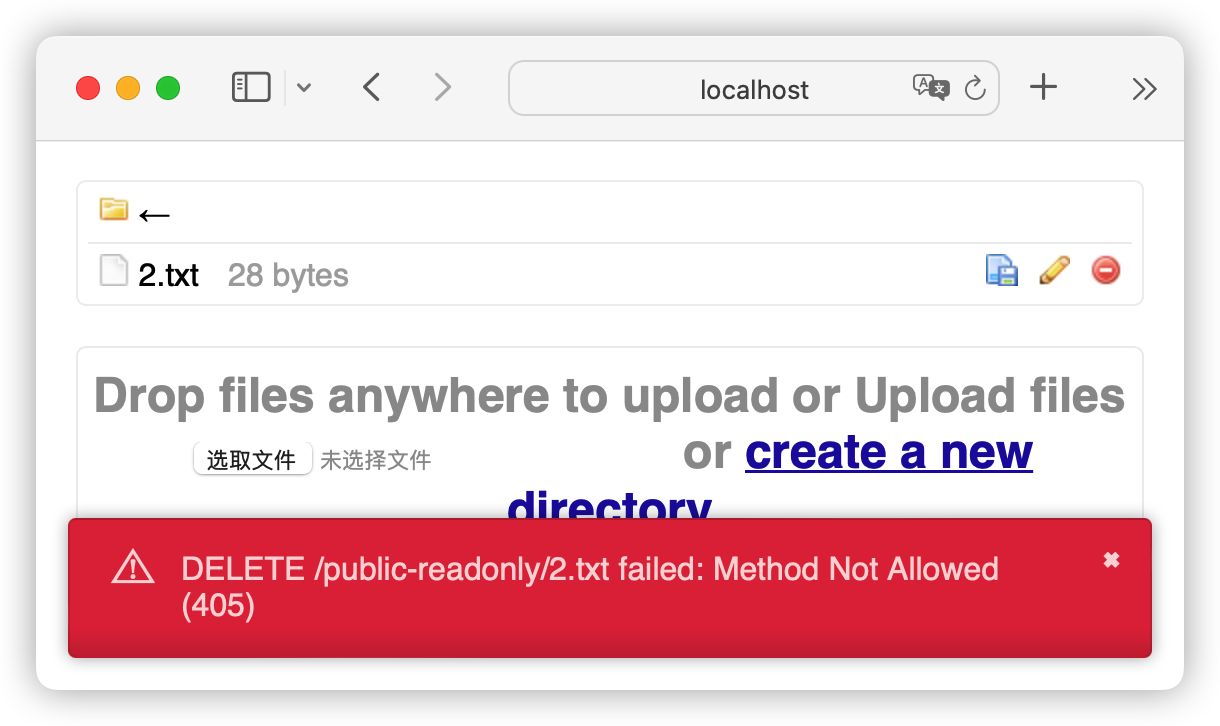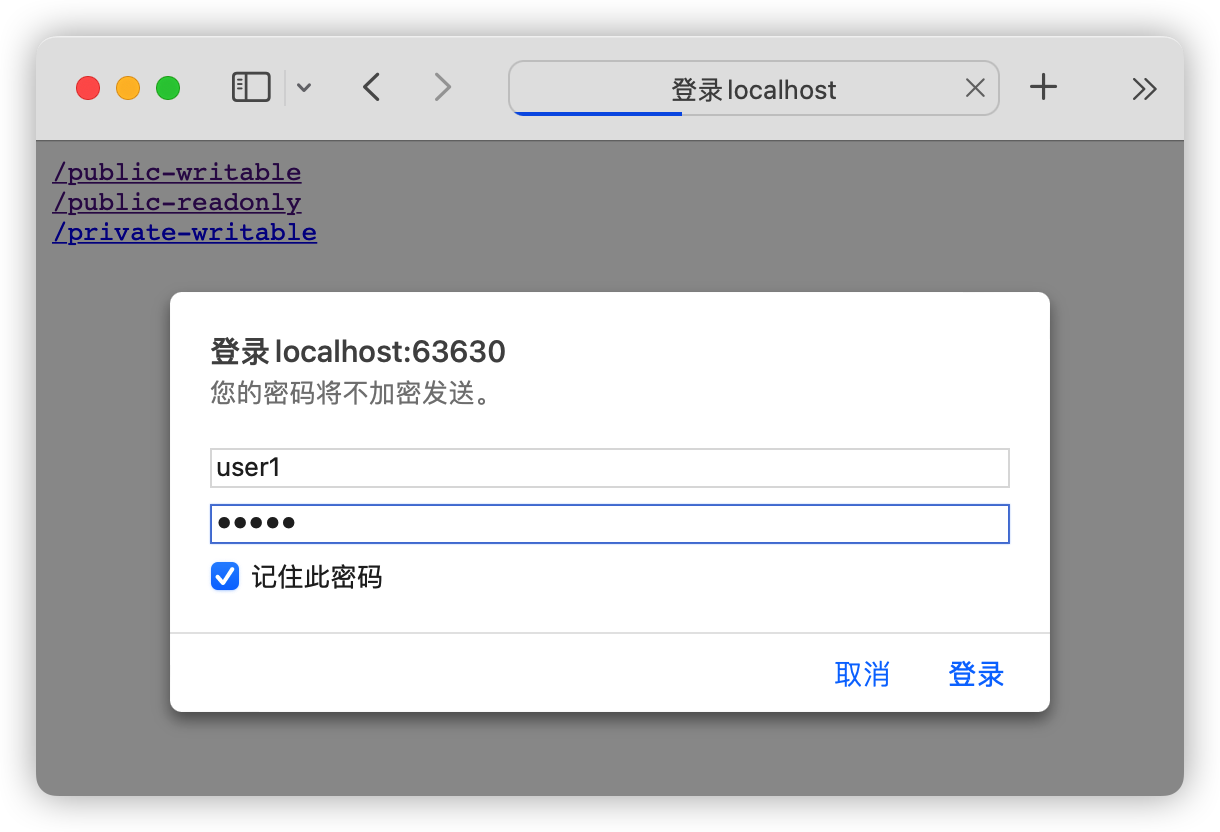Share local files with WebDAV, lightweight and very easy to use.
-
Based on Golang implementation, high performance
-
Finally compiled into a single binary file, no need for Apache and other environments, more stable
-
Support browser access
-
Multiple WebDAV services can be enabled under the same port, each with a different mount directory, user name, and password
-
Docker is well supported
Go to https://github.com/117503445/GoWebDAV/releases to download the latest binaries.
Then run . /gowebdav
GoWebDAV will automatically create the example file under the ./data path with the following file structure
> tree ./data
./data
├── public-writable
│ └── 1.txt
├── public-readonly
│ └── 2.txt
└── private-writable
└── 3.txtVisit http://localhost:80 with your browser and you will see 3 different GoWebDAV services.
where http://localhost:80/public-writable is the public-writable service that maps the local ./data/public-writable folder. It is Anonymizable and writable. You can view the contents of the file in the browser, as well as perform operations such as uploading and deleting.
http://localhost:80/public-readonly is the public-readonly service that maps the local ./data/public-readonly folder. It is Anonymizable and read-only. You can view the contents of the file in your browser, but you cannot upload, delete, etc.
http://localhost:80/private-writable is the private-writable service that maps the local ./data/private-writable folder. It is user-authenticated and writable. After logging in with user1 and pass1, you can view the contents of the files in the browser, as well as upload, delete, etc.
The dav parameter can also be specified to configure the local path, user authentication, read-only, etc. properties of the WebDAV service, as described in the Configuration Strings Description section. When dav is not specified, the default dav parameter used by GoWebDAV is /public-writable,./data/public-writable,null,null,false;/public-readonly,./data/public-readonly,null,null,true;/private-writable,./data/private-writable,user1,pass1,false.
The local file paths to be shared are /root/dir1 and /root/dir2.
docker run -it --name go_webdav -d -v /root/dir1:/root/dir1 -v /root/dir2:/root/dir2 -e dav="/dav1,/root/dir1,user1,pass1,true;/dav2,/root/dir2,null,null,false" -p 80:80 --restart=unless-stopped 117503445/go_webdav-e dav="/dav1,/root/dir1,user1,pass1,true;/dav2,/root/dir2,null,null,false"Indicates passing a configuration string into the Docker image.
Then open http://localhost/dav1 and http://localhost/dav2 in the browser or webdav client like raidrive.
You can pass the --dav parameter to change the configuration.
On Windows, the same call as quickstart is made as follows
// cmd
gowebdav_windows_amd64.exe --dav "/public-writable,./data/public-writable,null,null,false;/public-readonly,./data/public-readonly,null,null,true;/private-writable,./data/private-writable,user1,pass1,false"
// PowerShell
.\gowebdav_windows_amd64.exe --dav "/public-writable,./data/public-writable,null,null,false;/public-readonly,./data/public-readonly,null,null,true;/private-writable,./data/private-writable,user1,pass1,false"
On Windows, the same call as quickstart is made as follows
./gowebdav_linux_amd64 --dav "/public-writable,./data/public-writable,null,null,false;/public-readonly,./data/public-readonly,null,null,true;/private-writable,./data/private-writable,user1,pass1,false"The following is a specific explanation of dav
Use a semicolon to separate each WebDAV service configuration, which means that "/dav1,/root/dir1,user1,pass1,true;/dav2,/root/dir2,null,null,false" describes 2 services, which are
/dav1,/root/dir1,user1,pass1,false
and
/dav2,/root/dir2,null,null,true
The first service will mount the /root/dir1 directory of the Docker image under /dav1. The required username and password for access are user1 and pass1 respectively.
Then, according to the previous -v /root/dir1:/root/dir1, the mapping relationship with /root/dir1 of the physical machine can be completed and accessed.
The fifth parameter false indicates that this is a non-read-only service that supports addition, deletion, modification and query.
The second service will mount the /root/dir2 directory of the Docker image under /dav2. The user name and password required for access are null and null respectively. At this time, it means that the service can be accessed without a password. .
Then according to the previous -v /root/dir2:/root/dir2, you can complete the mapping relationship with /root/dir2 of the physical machine and access it.
The fifth parameter true indicates that this is a read-only service, only supports GET, does not support additions, deletions and modifications.
This method is recommended for file sharing without confidentiality requirements.
Expose /root/dir1, which requires authentication, and /root/dir2, which does not require authentication.
version: "3.9"
services:
go_webdav:
volumes:
- "/root/dir1:/root/dir1"
- "/root/dir2:/root/dir2"
environment:
- "dav=/dav1,/root/dir1,user1,pass1,true;/dav2,/root/dir2,null,null,false"
ports:
- "80:80"
restart: unless-stopped
image: 117503445/go_webdavGoWebdav is used to build a WebDAV-based file sharing server.
-
Samba is inconvenient to use on Windows clients, and it is difficult to use non-default ports.
-
FTP mount trouble.
-
NextCloud is too heavy and difficult to share files on the server.
Because I didn't see a server-side implementation that could meet the above features, this project recreated a WebDAV Server.
Rename config.yml.example to config.yml, configure in config.yml file
go run .
Using a layered build, the executable app is built through go build in the build layer, and then run in the prod layer. If you need to modify the structure of the configuration file later, you will also need to modify the Dockerfile.
docker build -t 117503445/go_webdav .
docker run --name go_webdav -d -v ${PWD}/TestDir1:/root/TestDir1 -v ${PWD}/TestDir2:/root/TestDir2 -e dav="/dav1,/root/TestDir1,user1,pass1,false;/dav2,/root/TestDir2,user2,pass2,true" -p 80:80 --restart=unless-stopped 117503445/go_webdavHTTP Basic Auth is used for authentication, and the account password is sent in clear text, which has no security at all. If important files or passwords are involved, be sure to use a gateway such as Nginx or Traefik to provide HTTPS.
https://github.com/dom111/webdav-js provides front-end support



